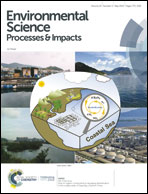Characterization of electrophilicity and oxidative potential of atmospheric carbonyls†
Abstract
Carbonyls are reactive and electrophilic compounds found ubiquitously in the atmosphere. The interactions between atmospheric carbonyls and biological nucleophiles (e.g., thiol-containing compounds) have important implications on their toxicity, but the underlying mechanisms have not been fully understood. In this study, we used combined computational and experimental approaches to assess the reactivities of atmospheric carbonyls in respect to their electrophilic properties. Global electrophilicity indexes (ω) were calculated based on density functional theory. The reactivities of carbonyls with thiols were assessed using the dithiothreitol (DTT) assay as a surrogate of biological nucleophilic antioxidants. The computational results indicated that the ω of a given carbonyl compound is largely influenced by its molecular structure and adjacent functional groups. The calculated ω values showed a strong linear correlation with the logarithm of measured carbonyl mass-normalized DTT consumption rates (r2 = 0.8378 and 0.9899 for simple and α,β-unsaturated carbonyls, respectively). The removal of DTT through the nucleophilic addition pathway was confirmed by the detection of carbonyl-DTT adducts using the gas chromatography/electron ionization-mass spectrometry (GC/EI-MS) technique. Our results demonstrated that electrophilicity index can be potentially used as a molecular descriptor to predict toxicity of atmospheric carbonyls towards thiol-containing biomolecules. This work also highlights the significance of carbonyls in interpreting DTT-based aerosol oxidative potential.



 Please wait while we load your content...
Please wait while we load your content...